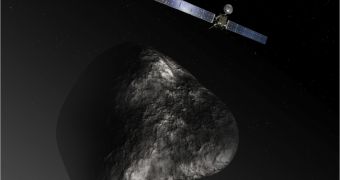Officials with the European Space Agency were successful in reestablishing contact with their Rosetta space probe earlier this month, on January 20. Now that the satellite is finally in contact after 31 months of hibernation, its instruments, including three payloads from NASA, are about to enter their respective testing and commissioning phases.
NASA experts announce that check-out operations on the three instruments are scheduled to begin soon, ahead of Rosetta's mid-year rendezvous with comet 67P/Churyumov-Gerasimenko. The spacecraft was launched from Earth on March 2, 2004, and put in hibernation mode in 2011.
After spending a record-breaking 957 days in this power-saving mode, the spacecraft was able to return to normal operations on Monday. Among its soon-to-be-commissioned instruments are an ultraviolet imaging spectrograph, a microwave thermometer and a plasma analyzer, all developed by NASA.
Various organizations in the United States are involved in 7 of the 21 instrument collaborations on Rosetta, in partnership with international collaborators. For example, the Double Focusing Mass Spectrometer tool is part of the Swiss-built Rosetta Orbiter Spectrometer for Ion and Neutral Analysis.
“US scientists are delighted the Rosetta mission gives us a chance to examine a comet in a way we've never seen one before – in orbit around it and as it kicks up in activity,” explains Rosetta project scientist Claudia Alexander, who is based at the NASA Jet Propulsion Laboratory (JPL), in Pasadena.
“The NASA suite of instruments will provide puzzle pieces the Rosetta science team as a whole will put together with the other pieces to paint a portrait of how a comet works and what it's made of,” the expert goes on to say.
One of the most important core instruments on Rosetta is the NASA-developed ALICE, which is an ultraviolet imaging spectrograph capable of analyzing the abundance and precise distribution of noble gases throughout the core of 67P/Churyumov-Gerasimenko. The Microwave Instrument for Rosetta Orbiter (MIRO) was also developed with participation from the American space agency. Its purpose is to measure with great precision of the abundance and temperatures of various chemicals on the surface of the comet, including water molecules or vapors.
The third NASA instrument is the Ion and Electron Sensor, which is a part of the Rosetta Plasma Consortium (RPC), a collection of five measuring tools designed to reveal the properties of plasma in the comet's tail in fine detail.
“Future robotic and human exploration missions to Mars, an asteroid and beyond will be accomplished via international partnerships combining worldwide scientific and engineering expertise,” comments the director of the NASA Planetary Science Division, Jim Green.

 14 DAY TRIAL //
14 DAY TRIAL //